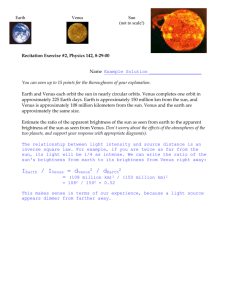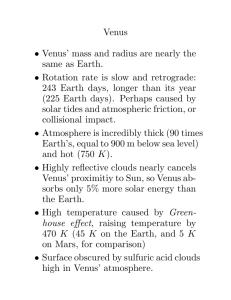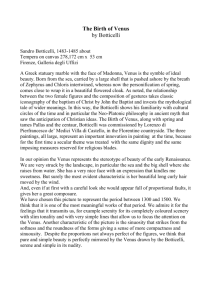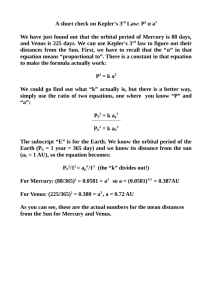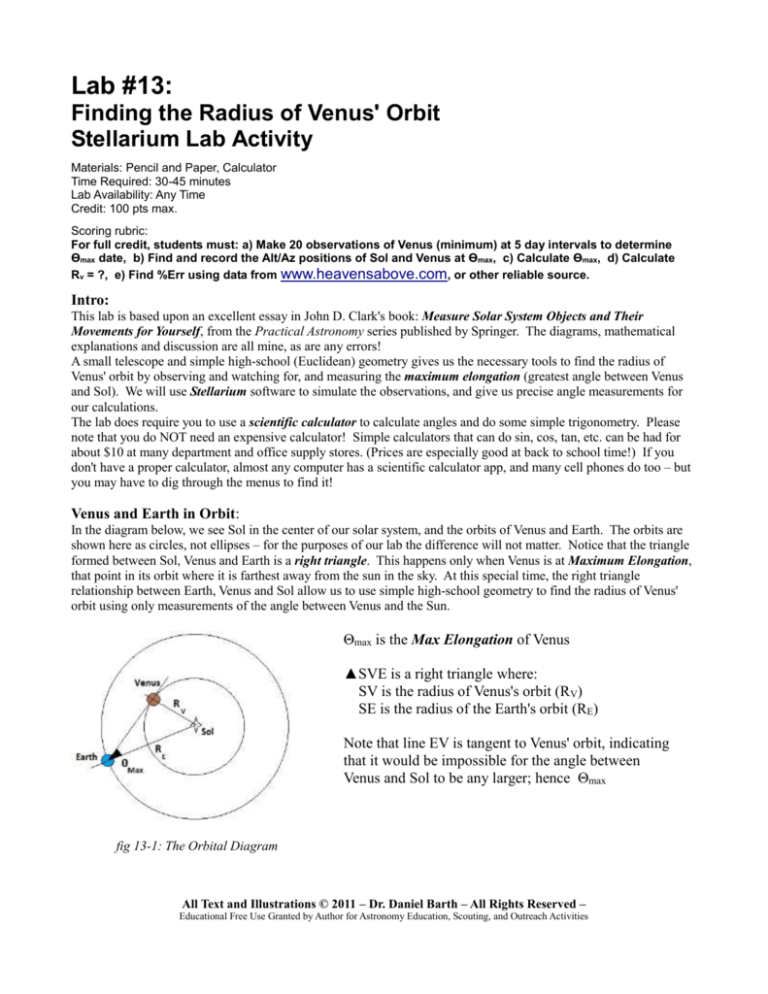
Lab #13:
Finding the Radius of Venus' Orbit
Stellarium Lab Activity
Materials: Pencil and Paper, Calculator
Time Required: 30-45 minutes
Lab Availability: Any Time
Credit: 100 pts max.
Scoring rubric:
For full credit, students must: a) Make 20 observations of Venus (minimum) at 5 day intervals to determine
ϴmax date, b) Find and record the Alt/Az positions of Sol and Venus at ϴmax, c) Calculate ϴmax, d) Calculate
Rv = ?, e) Find %Err using data from www.heavensabove.com, or other reliable source.
Intro:
This lab is based upon an excellent essay in John D. Clark's book: Measure Solar System Objects and Their
Movements for Yourself, from the Practical Astronomy series published by Springer. The diagrams, mathematical
explanations and discussion are all mine, as are any errors!
A small telescope and simple high-school (Euclidean) geometry gives us the necessary tools to find the radius of
Venus' orbit by observing and watching for, and measuring the maximum elongation (greatest angle between Venus
and Sol). We will use Stellarium software to simulate the observations, and give us precise angle measurements for
our calculations.
The lab does require you to use a scientific calculator to calculate angles and do some simple trigonometry. Please
note that you do NOT need an expensive calculator! Simple calculators that can do sin, cos, tan, etc. can be had for
about $10 at many department and office supply stores. (Prices are especially good at back to school time!) If you
don't have a proper calculator, almost any computer has a scientific calculator app, and many cell phones do too – but
you may have to dig through the menus to find it!
Venus and Earth in Orbit:
In the diagram below, we see Sol in the center of our solar system, and the orbits of Venus and Earth. The orbits are
shown here as circles, not ellipses – for the purposes of our lab the difference will not matter. Notice that the triangle
formed between Sol, Venus and Earth is a right triangle. This happens only when Venus is at Maximum Elongation,
that point in its orbit where it is farthest away from the sun in the sky. At this special time, the right triangle
relationship between Earth, Venus and Sol allow us to use simple high-school geometry to find the radius of Venus'
orbit using only measurements of the angle between Venus and the Sun.
Θmax is the Max Elongation of Venus
▲SVE is a right triangle where:
SV is the radius of Venus's orbit (RV)
SE is the radius of the Earth's orbit (RE)
Note that line EV is tangent to Venus' orbit, indicating
that it would be impossible for the angle between
Venus and Sol to be any larger; hence Θmax
fig 13-1: The Orbital Diagram
All Text and Illustrations © 2011 – Dr. Daniel Barth – All Rights Reserved –
Educational Free Use Granted by Author for Astronomy Education, Scouting, and Outreach Activities
In the diagram above, the Sol, Venus, Earth triangle is a right triangle. Let's redraw it here in a more familiar form
(the way most of us have seen it in a geometry book!)
Trigonometry tells us that the sine of an angle is
defined by the ratio of the opposite side divided by the
hypotenuse of the triangle.
As we can see in the equations to the right,
the sine of angle Θmax is equal to RV divided by RE.
Rearranging terms, we get: RV = RE sin Θ
Diagram
figure 13-2: Max Elongation
And since RE = 1 A.U., we can simplify to the final result: RV = sin ΘMax.
Making Observations:
This is fascinating as an exercise, but what does it mean to us as astronomers? How can we tell when Venus is at
maximum elongation? We could measure the angle between Venus and the Sun each day, and then find the day that
had the greatest separation – but we can do better than that!
When we observer Venus at maximum elongation, we are seeing it at a perfect 90-degree angle from the Sun. This
means that we must see Venus as a perfect half-disk! You can see this clearly in the diagram below:
figure 13-3: The Phase of Venus
When Venus forms a right triangle with Sol and Earth (as it does during maximum elongation), we must see Venus as
a half-lit disk! This means that if we observation Venus with a telescope (or with Stellarium!), and look for a perfect
half-phase of Venus – then measure the angle between Venus and Sol, we can use trigonometry to find the radius of
Venus' orbit!
To do this with Stellarium, we must first locate Venus in the sky. After you turn on Stellarium, turn to the eastern
horizon, and then advance the clock hour by hour until you see Venus appear in the sky well above the horizon.
Next, click on Venus to select it, and press the space-bar to move Venus to the center of the screen and keep it there.
With Venus centered on the screen, it is time to configure Stellarium to show us Venus without regard to the horizon,
or whether it is day or night! To do this, pull out the menu on the left side of the screen, and if you haven't already
done so, select the clock tab. Drag the clock window off to the side where it will not affect your work, but do not
close it!
Now select the third tab down – the Sky and Viewing Options tab, and open it. From the Sky menu, turn off the Show
All Text and Illustrations © 2011 – Dr. Daniel Barth – All Rights Reserved –
Educational Free Use Granted by Author for Astronomy Education, Scouting, and Outreach Activities
Atmosphere box. Next, go to the Landscape menu and turn off the Show Ground and the Show Fog boxes. Now
Stellarium shows the sky as it would appear if you were out in space in Earth's orbit, but without the pesky ground or
atmosphere to interfere with your view. Call this the “Hubble Perspective”!
You should still have Venus locked in the center of your screen. Use the scroll wheel on your mouse to zoom into
Venus until you can see the planet's disk clearly on the screen. For 2011, the maximum elongation of Venus occurred
very early in the year, so to find the nearest maximum elongation event, we have to move backward in time!
1. Start with today's date, and sketch the planet's phase. Note the poles on your sketch! Mark the terminator
carefully, as it will change slowly over time, and you must be able to see these changes in your sketches!
Mark the date underneath the box for each sketch!
2. Next, move the date seven days backward, and observe and record the phase again. Continue to do this until
you have gone a bit past the time of the max elongation event.
3. Adjust the days forward or backward one at a time, until you have the exact day of Venus at half-phase. And
in the very last box - draw Venus on the exact day of maximum elongation. Don't forget to record the date
below the box. Please note that the phases of Venus change very slowly, and everyone may not have the
exact same answer!
Table 13-1: Phase Observations of Venus w/ dates
Finding the Angle of Elongation:
In order to find the angle of elongation, we must measure the angular distance between Sol and the planet Venus.
That is, we must find the angle that separates them in the sky. If we want to do this in live sky, we must build a device
to measure angles – rather like a large protractor. But when we use Stellarium, the process is very different.
Stellarium will give us the positions of Sol and Venus to very great precision, but we must use a bit of high school
geometry to find the angular distance between them.
You may remember something from high-school algebra or geometry called the distance formula – this is used to find
the distance between two known points on an x-y plane. If that sounds scary – it needn't be, this is our old friend the
Pythagorean Theorem: a2 + b2 = c2, and we're going to use it to find angles in the sky!
Back on the computer, your screen should show Venus very close up, so you can see the perfect half-lit phase it is in.
Now we are going to use the zoom wheel on the mouse to pull back far enough to see both Sol and Venus on the
screen at the same time. In the diagram below, sketch in Sol and Venus, then click on each of them and record their
exact Altitude and Azimuth in degrees, minutes, seconds. In astronomy, we divide degrees the same we divide the
All Text and Illustrations © 2011 – Dr. Daniel Barth – All Rights Reserved –
Educational Free Use Granted by Author for Astronomy Education, Scouting, and Outreach Activities
hours on a clock face – that is, into minutes and seconds. For example, we write 62 degrees, 15 minutes, 22.5 seconds
as: 62o, 15', 22.5”.
figure 13-4: Plotting Positions of Sol & Venus
Note that each of the boxes above are
divided. Put the Dego, Min', Sec” value
in the top box, and put the converted
decimal value in the lower box.
In the graph above, draw a line between Sol and Venus. Now turn it into a right triangle, with the base parallel to the
horizon, and Sol and Venus at the corners; Earth, of course, is at the third point of this triangle. (It does not matter
whether Sol or Venus is in the upper corner.) Each of the sides of the triangle represents an angular distance in the
sky measured in degrees. This is a bit different from geometry class, where you measured lines off in centimeters or
inches! Our triangle is not a physical one drawn in paper, rather it stretches millions of miles out into space; and
although our triangle is measured in degrees instead of centimeters, the geometry of triangles works just the same!
(Hurray for Pythagoras!)
Converting Angles to Decimal Units:
Before we use the Pythagorean theorem, we must convert our degrees-minutes-seconds measurements into more
familiar decimal form. While it is possible to do the math in base 60 (Kepler, Copernicus, and Galileo did it this
way!), it is a formidable challenge. Using the Arabic system of decimal notation, the familiar math we use every day,
is much easier!
To convert our D-M-S measurements, we must begin by converting seconds into a decimal fraction of a minute. This
isn't as hard as it sounds! We simply divide our measurement in seconds by 60, and add the decimal amount to the
minutes in our measurement. Look at the example below, and convert your Altitude and Azimuth coordinates from
Sol and Venus above into proper decimal notation. Record the results in the lower box of the data table for each
conversion. Show the work for one of these conversions neatly below.
All Text and Illustrations © 2011 – Dr. Daniel Barth – All Rights Reserved –
Educational Free Use Granted by Author for Astronomy Education, Scouting, and Outreach Activities
Figure 13-5: Decimal Conversion Example
Show your conversion work example here:
Using the Distance Formula:
Now that we have proper Alt/Az coordinates for both Sol and Venus in their correct decimal form, it is time to use our
old friend, the Pythagorean Theorem, otherwise known as the Distance Formula.
On the diagram below, we see Venus and Sol plotted on an Alt/Az position graph, and with Earth, they make a right
triangle. The hypotenuse (the longest side of the triangle), represents the maximum angle of separation between
Venus and Sol as seen from Earth. This is the max-elongation angle we have been seeking! You can see below how
the Pythagorean theorem comes into play here. Notice that the length of the Δ Alt and Δ Az sides are found by
subtracting the position of upper corner (Sol) from the position of the lower corner (Venus). These positions, of
course are the ones we converted to decimal notation on the last page! Follow the example and show your own
distance formula calculation using your data from figure 13-4 in the space below.
Figure 13-6: Using the Distance Formula
Show your Distance Formula work here:
All Text and Illustrations © 2011 – Dr. Daniel Barth – All Rights Reserved –
Educational Free Use Granted by Author for Astronomy Education, Scouting, and Outreach Activities
All Text and Illustrations © 2011 – Dr. Daniel Barth – All Rights Reserved –
Educational Free Use Granted by Author for Astronomy Education, Scouting, and Outreach Activities
Finding the Radius of Venus' Orbit:
Now at last, we can determine the radius of Venus' orbit in Astronomical Units (1 A.U. is defined as the average
distance between the Earth and the Sun.) Remember from figure 13-2, we found that the radius of Venus orbit was
simply the sine of the angle ΘMax. We have also used the distance formula successfully, and determined the value of
RV using the ΘMax value we found on the previous page. Fill in the calculation table below:
Table 13-2:
Finding RV
Finding %Error:
Finally, we must determine how close our value for Venus' orbital radius is to the established value; we do this by
determining the %Error value for our experimental measurement. %Error tells us how far off we were in comparison
to the size of our theoretical target value. In other words, to say you “missed by a mile” is very bad in pistol shooting
(small target, comparatively large error). But if you “missed by a mile” when navigating a space ship to Mars is a
very good result because the error is very small compared to the distance traveled (small %Err). To find %Error, use
the example below, insert your own value for RV from table 13-2, and finish the calculation.
Table 13-3: Determining Percent Error
Conclusion:
If your final %Err value was less than 5%, you did quite well! A simple observation and a knowledge of basic
geometry and we can reach out and understand the orbits of the planets themselves! The power of the Pythagorean
theorem and the knowledge of ratios of triangles allows us to understand the motion of the planets and to predict them
using only a simple telescope and some basic mathematics!
All Text and Illustrations © 2011 – Dr. Daniel Barth – All Rights Reserved –
Educational Free Use Granted by Author for Astronomy Education, Scouting, and Outreach Activities



